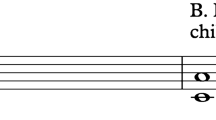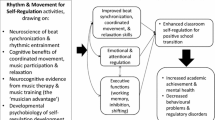Abstract
This study evaluated the effects of individually composed songs on the independent behaviors of two young children with autism during the morning greeting/entry routine into their inclusive classrooms. A music therapist composed a song for each child related to the steps of the morning greeting routine and taught the children’s teachers to sing the songs during the routine. The effects were evaluated using a single subject withdrawal design. The results indicate that the songs, with modifications for one child, assisted the children in entering the classroom, greeting the teacher and/or peers and engaging in play. For one child, the number of peers who greeted him was also measured, and increased when the song was used.



Similar content being viewed by others
Notes
Interested readers can contact the first author to get a music score.
References
Aldridge, D. (Ed.) (2005). Case study designs in music therapy. London, England; Bristol, PA: Jessica Kingsley Publishers.
Alger, H. A. (1984). Transitions: Alternatives to manipulative management technique. Young Children, 39(6), 16–25.
Applebaum, E., Egel, A. L., Koegel, R. L., & Imhoff, B. (1979). Measuring musical abilities of autistic children. Journal of Autism and Developmental Disorders, 9, 279–285.
American Association of Music Therapy (AMTA) (2002). Music therapy and individuals with diagnosis on the autism spectrum. Retrieved February 12, 2005 from the Internet: http://www.musictherapy.org/factsheets/autism.html.
American Psychiatry Association (APA) (2000). Diagnostic and statistical manual of mental disorders (4th ed.), Text Revision. Washington, DC: Author.
Baker, B. S. (1992). The use of music with autistic children. Journal of Psychosocial Nursing Mental Health Service, 20(4), 31–34.
Bailey, L. M. (1984). The use of songs in music therapy with cancer patients and their families. Journal of Music Therapy, 4, 5–17.
Bredekamp, S., & Copple, C. (Eds.). (1997). Developmentally appropriate practice in early childhood programs (Rev. ed.). Washington, DC: National Association for the Education of Young Children.
Brownell, M. K. (2002). Musically adapted social stories to modify behaviors in students with autism: Four case studies. Journal of Music Therapy, 39, 117–144.
Bryan, L. C., & Gast, D. L. (2000). Teaching on-task and on-schedule behaviors to high-functioning children with autism via picture activity schedules. Journal of Autism Development Disorder, 30, 553–567.
Bondy, A. S., & Frost, L. A. (1994). The picture exchange communication system. Focus on Autism, 9, 1–19.
Bunday, E. M. (1995). The effects of signed and spoken words taught with music on sign and speech imitation by children with autism. Journal of Music Therapy, 32, 189–202.
Carta, J. J., Greenwood, C. R., & Robinson, S. (1987). Application of an eco-behavioral approach to the evaluation of early intervention programs. In R. Prinz (Ed.), Advances in the behavioral assessment of children and families (Vol. 3, pp. 123–155). Greenwich, CT: JAI Press.
Dawson, G., & Osterling, J. (1997). Early intervention in autism. In M. J. Guralnick (Ed.), The effectiveness of early intervention (pp. 307–326). Baltimore: Paul H. Brookes.
Enoch, A. (2001). Let’s do it again. All Together Now! (ATN), 7(1), 5–7.
Furman, A. (2001). Young children with autism spectrum disorder. Early Childhood Connections, 7(2), 43–49.
Furman, A. (2002). Music therapy for learners in a community early education public school. In B. L. Wilson (Ed.), Models of music therapy interventions in school settings (2nd ed., pp. 369–388). Silver Spring, MD: The American Music Therapy Association, Inc.
Gottschewski, K. (2001). Autismus aus der Innenperspektive und Musiktherapie [Autism from an inside-out perspective and music therapy]. In D. Aldridge (Ed.), Kairos V: Musiktherapie mit Kindern: Beitraege zur Musiktherapie in der Medizin (pp. 40–57). Bern; Goettingen; Toronto; Seattle: Verlag Hans Huber.
Hobson, R. P., & Lee, A. (1998). Hello and goodbye: A study of social engagement in autism. Journal of Autism and Developmental Disorders, 28, 117–127.
Humpal, M. E. (1998). Information sharing: Song repertoire of young children. Music Therapy Perspectives, 19, 37–38.
Humpal, M. E., & Wolf, J. (2003). Music in the inclusive environment. Young Children, 58, 103–107.
Kemmis, B. L., & Dunn, W. (1996). Collaborative consultation: The efficacy of remedial and compensatory interventions in school context. The American Journal of Occupational Therapy, 59, 709–717.
Kostka, M. J. (1993). A comparison of selected behaviors of students with autism in special education and regular music classes. Music Therapy Perspectives, 11, 57–60.
Mayer-Johnson, R. (1992). The picture communication symbols. Solana Beach, CA: Mayer-Johnson, Co.
Marcus, L., Schopler, E., & Lord, C. (2001). TEACCH Services for preschool children. In J. S. Handelman & S. L. Harris (Eds.), Preschool education programs for children with autism (2nd ed., pp. 215–232). Austin, TX: Pro-Ed.
McWilliam, R. A. (Ed.) (1996). Rethinking pull-out services in early intervention: A professional resource. Baltimore, MD: Paul H. Brookes.
Mesibov, G. B., Adams, L., & Klinger, L. (1997). Autism: Understanding the disorder. NY: Plenum Press.
National Research Council (2001). Educating children with autism. Committee on educational interventions for children with autism. Division of Behavioral and Social Science and Education. Washington, DC: National Academy Press.
Nordoff, P., & Robbins, C. (1995). Greetings and goodbyes: A Nordoff-Robbins collection for the classroom use. Bryn Mawr, PA: Theodore Presser.
Osborn, K., & Osborn, D. (1981). Discipline and classroom management. Athens, GA: Education Association.
Pasiali, V. (2004). The use of prescriptive therapeutic songs in a home-based environment to promote social skills acquisition by children with autism: Three case studies. Music Therapy Perspectives, 22(1), 11–20.
Sandall, S., McLean, M. E., & Smith, B. J. (2000). DEC: Recommended practices in early intervention/early childhood special education. Longmont, CO: Sopris West.
Schmit, J., Alper, S., Raschke, D., & Ryndak, D. (2000). Effects of using a photographic cueing package during routine school transitions with a child who has autism. Mental Retardation 38, 131–137.
Schopler, E., Reichler, R., & Renner, B. (1988). The Childhood Autism Rating Scale (CARS). Los Angeles, CA: Western Psychological.
Snell, A. M. (2002). Music therapy for learners with autism in a public school setting. In B. L. Wilson (Ed.), Models of music therapy interventions in school settings (2nd ed., pp. 211–275). Silver Spring, MD: The American Music Therapy Association.
Strain, P. S., McGee, G. G., & Kohler, F. W. (2001). Inclusion of children with autism in early intervention environments. In M. J. Guralnick (Ed), Early childhood inclusion: Focus on change (pp. 337–363). Baltimore: Paul Brookes.
Tawney, J. W., & Gast, D. L. (1984). Single subject research in special education. Columbus: Merrill.
Thaut, M. H. (1987). Visual versus auditory (musical) stimulus preferences in autistic children: A pilot study. Journal of Autism and Developmental Disorders, 17, 425–432.
Thaut, M. H. (1988). Measuring musical responsiveness in autistic children: A comparative analysis of improvised musical tone sequences of autistic, normal and mentally retarded individuals. Journal of Autism and Developmental Disorders, 18, 561–571.
Trillingsgaard, A. (1999). The script model in relation to autism. European Children Adolescence Psychiatry, 8(1), 45–49.
Venn, M. L., Wolery, M., Werts, M. G., Morris, A., DeCesare, L. D., & Cuffs, M. S. (1993). Embedding instruction in art activities to teach preschoolers with disabilities to imitate their peers. Early Childhood Research Quarterly, 8, 277–294.
Williams, D. (1996). Autism: An inside-out approach. London, Bristol, PA: Jessica Kingsley.
Wimpory, D., Chadwick, P., & Nash, S. (1995). Brief report: Musical Interaction Therapy for children with autism: An evaluative case study with two-year follow-up. Journal of Autism and Developmental Disorders, 25(5), 541–552.
Wolery, M., Ault, M. J., & Doyle, P. M. (1992). Teaching students with moderate and severe disabilities: Use of response prompting strategies. White Plains, NY: Longman.
Acknowledgement
This study is a part of a series of single case studies investigating embedded music therapy interventions for the inclusion of young children with autism spectrum disorders in a community-based, university-affiliated Family and Child Care Program. The authors wish to acknowledge Dr. Ann N. Garfinkle for her contributions to the study. Gratitude also goes to the children and families, teachers and colleagues for their participation, dedication, and collaboration in this study.
Author information
Authors and Affiliations
Corresponding author
Rights and permissions
About this article
Cite this article
Kern, P., Wolery, M. & Aldridge, D. Use of Songs to Promote Independence in Morning Greeting Routines For Young Children With Autism. J Autism Dev Disord 37, 1264–1271 (2007). https://doi.org/10.1007/s10803-006-0272-1
Received:
Accepted:
Published:
Issue Date:
DOI: https://doi.org/10.1007/s10803-006-0272-1




